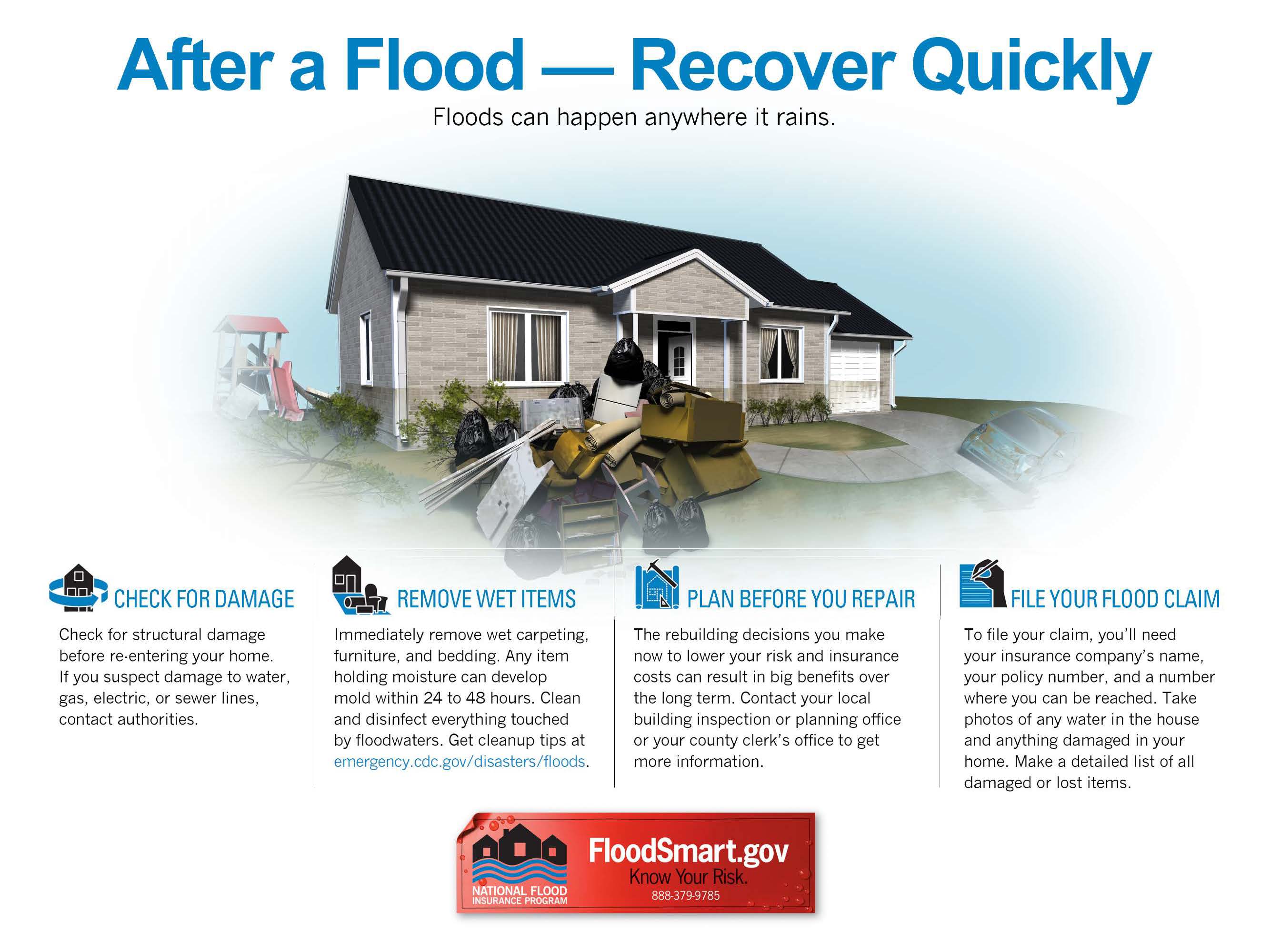Preparing for Hazardous Weather: After a Flood
In addition to high wind, hurricanes, tropical storms and tropical depressions can produce life-threatening storm surge, heavy rainfall and flooding. According to the National Hurricane Center, 88 percent of all deaths in the U.S. from these weather events are a result of storm surge, rainfall flooding, high surf, and deaths just offshore (within 50 nautical miles of the coast). With Hurricane Matthew threatening the east coast, make sure you know what to do before, during and after the storm to keep you and your family safe from these threatening conditions.
This information is derived from the Flood Planning and Resilience Guide for Hyde County, North Carolina prepared by North Carolina Sea Grant, as well as the Flooding and Its Aftermath fact sheet.
Beware of Hazards
The following tips are from FEMA’s 2013 After The Flood fact sheet.
- Check for structural damage before re-entering your home. Contact the appropriate professionals immediately if you suspect damage to water, gas, electric and sewer lines.
- Throw away food that has come in contact with floodwaters. Boil water until authorities declare the water supply safe to drink.
File Your Flood Insurance Claim
Follow these four steps, taken from FEMA’s 2014 Flood Insurance Claims Handbook F-687, to prepare your claim immediately after a flood.
1. Contact Your Agent or Company Representative to Report Your Loss: Have ready the name of your insurance company, policy number and a phone number and/or email address where you can be reached. All flood insurance policies require you to give prompt written notice of loss. If you get in touch with your agent or company representative directly, they will advise you how to file your notice of loss. Otherwise, you must send a written notice to your insurance company with your policy number.
2. Separate Your Property: Your policy also requires you to separate damaged property from undamaged property. Don’t throw anything away before an adjuster has seen it, unless local law requires you to. In that case, take photos of the property before disposing of it and keep samples for the adjuster to see. (For example, cut out a piece of wall-to-wall carpet.) Do all you can to protect undamaged property. However, prior to signing an agreement/contract with a cleaning, remediation or maintenance contractor, you should consult with your flood adjuster or flood insurer concerning coverage.
3. Make a List of Damaged Contents: If you’ve purchased contents coverage, make a list of damaged property. If you prepared comprehensive lists before the flood, this should be relatively easy. List the quantity of each item, a description, brand name, where it was purchased, cost, model, serial number (if appropriate), and your estimate of the loss amount. Attach your bills, receipts, photos and any other documents.
4. List Areas of Structural Damage: As you look over your property, make a list of any areas of structural damage you want to point out to the insurance adjuster.
Clean Up Structures
If you have flood insurance, file your claim first and always take actions required by your claims adjuster. Then check the most recent guidance by FEMA to begin cleaning your property. The following tips are from FEMA’s 2013 After The Flood fact sheet.
- Prevent mold by removing wet contents. Wet carpeting, furniture, bedding and any other items holding moisture or water inside the building can develop mold within 24 to 48 hours.
- If an item has been wet for less than 48 hours, help control mold growth by cleaning with a phenolic or pine-oil cleaner (non-ammonia detergent, soap or commercial cleaner) and disinfecting with a 10 percent bleach solution (1-1/2 cups of bleach in a gallon of water). Items should then be completely dried and monitored for several days for any fungal growth and odors.
- Thoroughly dry out the building’s interior. Portable dehumidifiers are useful, and rental costs may be covered under your flood policy. An air conditioner also can be used to start the drying-out process.
- If the walls are damaged, take photographs of the baseboard. Then remove the baseboard. Knock small holes at floor level in the drywall, between the wall studs. This will permit moisture trapped behind the drywall to seep out and start drying.
- Have your furnace checked for damage. Your water heater may work, but if the floodwater covered part or the entire tank, the insulation between the walls may be damaged. Obtain an estimate to replace the damaged furnace and water heater.
- Exercise caution and do not approach wild animals that take refuge in your home. Wild animals often seek refuge from floodwaters on upper levels of homes and have been known to remain after water recedes. Call the Hyde County Sheriff’s Department or 911 to handle the situation.
For More Information
- For FEMA Disaster Assistance, call 1-800-621-3362.
- For general flood insurance questions, call 1-800-427-4661, or contact your insurance company or insurance agent.
Get Coverage for Significant Damage
If a flood damages your home or business, you may be required by law or ordinance to meet certain building compliancy requirements in your community to reduce future flood damage. To help with these costs, the National Flood Insurance Program includes Increased Cost of Compliance, or ICC, coverage for all eligible properties insured under the Standard Flood Insurance Policy. You may file a claim for your ICC coverage in three instances:
- If your community determines that your home or business is damaged by a flood to the point that repairs will cost 50 percent or more of the building’s pre-damage market value (a lower threshold can be adopted by law or ordinance). This is called substantial damage.
- If your community has a repetitive loss provision in its floodplain management ordinance and determines that your home or business was damaged by a flood twice in the past 10 years, where the cost of repairing the flood damage, on the average, equaled or exceeded 25 percent of its market value at the time of each flood. This is called repetitive damage. Additionally, there must have been flood insurance claim payments for each of the two flood losses.[JW2]
- If you participate in a FEMA-sponsored grant program and meet eligibility requirements.
Click here for information on what to do after a before and during a flood.
- Categories:



